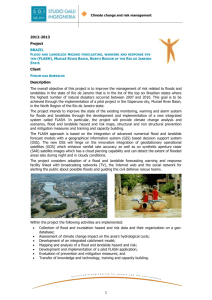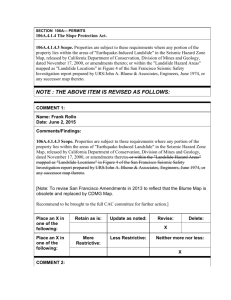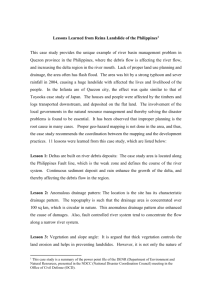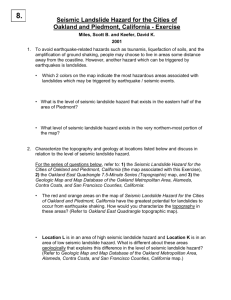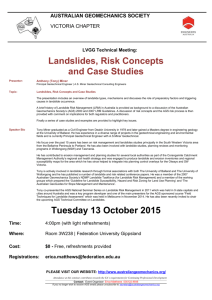Landslide hazard overlay code
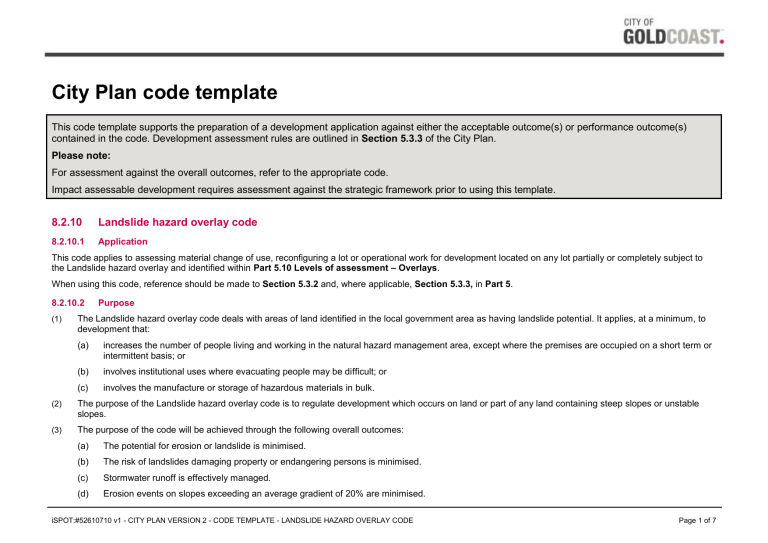
City Plan code template
This code template supports the preparation of a development application against either the acceptable outcome(s) or performance outcome(s) contained in the code. Development assessment rules are outlined in Section 5.3.3
of the City Plan.
Please note:
For assessment against the overall outcomes, refer to the appropriate code.
Impact assessable development requires assessment against the strategic framework prior to using this template.
8.2.10 Landslide hazard overlay code
8.2.10.1 Application
This code applies to assessing material change of use, reconfiguring a lot or operational work for development located on any lot partially or completely subject to the Landslide hazard overlay and identified within Part 5.10 Levels of assessment – Overlays .
When using this code, reference should be made to Section 5.3.2
and, where applicable, Section 5.3.3, in Part 5 .
8.2.10.2 Purpose
(1) The Landslide hazard overlay code deals with areas of land identified in the local government area as having landslide potential. It applies, at a minimum, to development that:
(a) increases the number of people living and working in the natural hazard management area, except where the premises are occupied on a short term or intermittent basis; or
(b) involves institutional uses where evacuating people may be difficult; or
(c) involves the manufacture or storage of hazardous materials in bulk.
(2)
(3)
The purpose of the Landslide hazard overlay code is to regulate development which occurs on land or part of any land containing steep slopes or unstable slopes.
The purpose of the code will be achieved through the following overall outcomes:
(a) The potential for erosion or landslide is minimised.
(b) The risk of landslides damaging property or endangering persons is minimised.
(c) Stormwater runoff is effectively managed.
(d) Erosion events on slopes exceeding an average gradient of 20% are minimised. iSPOT:#52610710 v1 - CITY PLAN VERSION 2 - CODE TEMPLATE - LANDSLIDE HAZARD OVERLAY CODE Page 1 of 7
(e) Safe and efficient vehicular access onto steeply sloping land is provided.
8.2.10.3 Criteria for assessment
Table 8.2.10-2: Landslide hazard overlay code – for assessable development
Performance outcomes
Site slope constraints
PO1
Development must be certified by an
RPEQ as being responsive to the constraints of steeply sloping land.
Stormwater drainage
PO2
Development must ensure that stormwater runoff does not increase the susceptibility of the site to landslide and does not cause any detriment to the natural environment or to any other lots.
Cut and fill work
PO3
Cut and fill work must not adversely affect slope stability or create erosion
Acceptable outcomes
AO1
Development is not to be undertaken on any lot partially or completely identified on the Landslide hazard overlay map , unless certification is provided by an RPEQ, confirming that the proposed development is appropriate for the sloping nature of the site, and that the risk of landslide adversely affecting the subject lot, adjoining properties and the proposed development is at a low level.
Does the proposal meet the acceptable outcome?
If not, justify how the proposal meets either the performance outcome or overall outcome
AO2.1
Stormwater drainage (including roof guttering and rainwater tank overflows) is managed to avoid an increase in onsite groundwater, ponding of water and water concentration into slopes and discharges to a lawful point of discharge.
AO2.2
Stormwater drainage is in accordance with SC6.9 City Plan policy
– Land development guidelines .
AO3.1
Cuts and fills should be minimised. The height of cut and/or fill, whether
Internal use iSPOT:#52610710 v1 - CITY PLAN VERSION 2 - CODE TEMPLATE - LANDSLIDE HAZARD OVERLAY CODE Page 2 of 7
Performance outcomes potential.
Acceptable outcomes retained or not, does not exceed:
(a) 900mm adjoining a public area
(e.g. roads, public open space areas);
(b) 1200mm adjoining a residential site;
(c) 2500mm adjoining a nonresidential site.
OR
Cuts greater than 900mm height are separated by terraces with a minimum width of 1.2m or equal to the height of the cut, whichever is greater, that incorporates drainage provisions in accordance with Council’s SC6.9 City
Plan policy
– Land development guidelines .
AO3.2
No crest of any cut or toe of any fill, or any part of any retaining wall or structure, is located closer than 600mm to any boundary of the lot, unless the prior approval of both landowners and the Council, or its delegate, has been obtained.
AO3.3
Cut and/or fill on slopes steeper than
1V:2H (26º) are retained at the time of earthworks by retaining structures or other stabilisation methods, in accordance with SC6.9 City Plan policy
– Land development guidelines .
AO3.4
All retaining walls on lots identified on the Landslide hazard overlay map are
Does the proposal meet the acceptable outcome?
If not, justify how the proposal meets either the performance outcome or overall outcome
Internal use iSPOT:#52610710 v1 - CITY PLAN VERSION 2 - CODE TEMPLATE - LANDSLIDE HAZARD OVERLAY CODE Page 3 of 7
Performance outcomes
Wastewater
PO4
Wastewater disposal must not create or increase the likelihood of instability on the site or neighbouring sites.
Slope constraints and stability
PO5
Development on any lot partially or completely mapped as moderate, high or very high landslide hazard, as identified on the Landslide hazard overlay map, is supported by an RPEQ certified geotechnical report, which adequately assesses and documents the site’s geotechnical stability and constraints, and incorporates necessary mitigation measures so that the level of landslide
Acceptable outcomes designed and certified by an RPEQ as not adversely affecting the site’s overall stability. Boulder walls must not be used as retaining walls on sites steeper than 20%.
AO3.5
Non-retained cut and/or fill on slopes are stabilised and protected against scour and erosion by suitable measures, such as grassing, dense landscaping or other protective measures, in accordance with SC6.9
City Plan policy – Land development guidelines .
Does the proposal meet the acceptable outcome?
If not, justify how the proposal meets either the performance outcome or overall outcome
AO4
All wastewater is disposed of via connection to sewerage reticulation.
OR
Where sewerage reticulation is not available on site, effluent disposal areas are located so as to not cause potential instability. Subsurface disposal of effluent is not to be used.
AO5
A geotechnical stability assessment report, which is prepared and certified by an RPEQ, includes:
(a) the following information:
(i) boundary dimensions;
(ii) location of easements;
(iii) existing and proposed services, such as sewer, stormwater, gas, electricity,
Internal use iSPOT:#52610710 v1 - CITY PLAN VERSION 2 - CODE TEMPLATE - LANDSLIDE HAZARD OVERLAY CODE Page 4 of 7
Performance outcomes risk to property and persons is low.
Acceptable outcomes telephone, and other utility services;
(iv) contour lines to AHD
(500mm vertical intervals);
(v) street front kerb locations, crossovers, side gully pit locations, driveway locations and slope;
(vi) off-street parking locations, building locations and setback dimensions;
(vii) earthwork details and building pad levels;
(viii) retaining wall locations, type, extent, height, and offset from boundaries;
(ix) existing and proposed onsite drainage systems;
(x) identification of trees to be removed or retained;
(xi) fencing extent, location, height and depth;
(xii) swimming pool location, level and depth;
(xiii) ancillary structures, such as pergolas and sheds;
(xiv) landscaping, lawn areas, paved areas, mass planting areas and trees;
(xv) slope angles;
(xvi) slope shape and features;
(xvii) parent rock type/soil type;
(xviii) engineering properties of sub-surface materials;
(xix) concentration of surface water;
Does the proposal meet the acceptable outcome?
If not, justify how the proposal meets either the performance outcome or overall outcome
Internal use iSPOT:#52610710 v1 - CITY PLAN VERSION 2 - CODE TEMPLATE - LANDSLIDE HAZARD OVERLAY CODE Page 5 of 7
Performance outcomes Acceptable outcomes
(xx) concentration of ground water;
(xxi) evidence of instability on the site and adjoining areas;
(xxii) history of instability on the site and adjoining areas; and
(xxiii) geotechnical model of the site.
(b) a site-specific landslip susceptibility frequency analysis, including analysis of each proposed lot;
(c) if the outcome of the landslip susceptibility frequency analysis is moderate or higher, a risk assessment in accordance with the
AGS Landslide Risk Management
2007 Guidelines ;
(d) an assessment of the suitability of the site for the proposed development having regard to (a)
–
(c);
(e) a foundation investigation report that determines the site classification for the lot/each proposed lot in accordance with AS
2870 Residential Slabs and
Footings and provides recommendations for foundation design;
(f) identification of any areas on the lot/within proposed lots where development must not occur;
(g) certification from the RPEQ confirming that the site (and for subdivisions, each proposed lot) achieves a landslide risk rating of
‘low’ or better and the site/lot is
Does the proposal meet the acceptable outcome?
If not, justify how the proposal meets either the performance outcome or overall outcome
Internal use iSPOT:#52610710 v1 - CITY PLAN VERSION 2 - CODE TEMPLATE - LANDSLIDE HAZARD OVERLAY CODE Page 6 of 7
Performance outcomes
Access (for subdivision only)
PO6
Development on steep slopes must ensure that safe and efficient access by vehicles and pedestrians can be achieved.
Acceptable outcomes suitable for its intended use; and
(h) recommendations for any necessary mitigation measures, construction measures and design changes to be implemented to ensure the stability of the site and adjoining areas is not adversely affected and to ensure long-term stability of the site.
AO6
The building envelope within every lot is accessible by a legal road access, in compliance with SC6.9 City Plan policy
– Land development guidelines .
Does the proposal meet the acceptable outcome?
If not, justify how the proposal meets either the performance outcome or overall outcome
Internal use iSPOT:#52610710 v1 - CITY PLAN VERSION 2 - CODE TEMPLATE - LANDSLIDE HAZARD OVERLAY CODE Page 7 of 7
